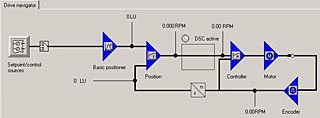EPos basic positioner Siemens
Обзор
Integrated functionality for absolute and relative positioning of linear and rotary axes with motor encoders or machine encoders.


The EPos basic positioner in the SINAMICS S120 drive system provides powerful and precise positioning functions. Due to its flexibility and adaptability, the basic positioner can be used for a wide range of positioning tasks.
The functions are easy to handle both during commissioning and during operation, and the comprehensive monitoring functions are outstanding.
In many applications, external position controls can thus be dispensed with.
The EPos basic positioner is used to position linear and rotary axes (modulo) in absolute/relative terms with rotary as well as linear motor encoder or machine encoder (indirect or direct measuring system).
EPos is a function module that can be activated in Servo Control and in Vector Control.
User-friendly configuring and commissioning including control panel (operation using PC) and diagnostics with the STARTER commissioning tool.
In addition to extremely flexible positioning functions, EPos offers a high degree of user-friendliness and reliability thanks to integral monitoring and compensation functions.
Different operating modes and their functionality increase flexibility and plant productivity, for example, by means of "on-the-fly" and bumpless correction of the Motion Control.
Preconfigured PROFIdrive positioning frames are available which, when selected, automatically establish the internal "connection" to the basic positioner.
Functionality of the EPos basic positioner
Lower-level closed-loop position control with the following essential components
- Position actual value sensing (including the lower-level measuring probe evaluation and reference mark search)
- Position controller (including limits, adaptation and pre-control calculation)
- Monitoring functions (standstill, positioning and dynamic following error monitoring, cam signals)
Mechanical system
- Backlash compensation
- Modulo offset
Limits
- Speed/acceleration/delay/jerk limitation
- Software limit switch (traversing range limitation by means of position setpoint evaluation)
- Stop cams (traversing range limitation by means of hardware limit switch evaluation)
Homing and alignment
- Set reference point (for an axis at standstill that has reached its target position)
- Search for reference (separate mode including reversing cam functionality, automatic reversal of direction, homing to "output cam and encoder zero mark" or only "encoder zero mark" or "external zero mark (BERO)")
- Flying referencing (seamless homing possible during "normal" traversing with the aid of the measuring input evaluation; generally evaluation, e.g. of a BERO. Subordinate function for the modes "jog", "direct setpoint specification/MDI" and "traversing blocks").
- Absolute encoder alignment
Traversing blocks mode (64 traversing blocks)
- Positioning using traversing blocks that can be stored in the drive unit including block change enable conditions and specific tasks for an axis that was previously referenced
- Traversing block editor using STARTER
- A traversing block contains the following information:
- Job number and job (e.g. positioning, waiting, GOTO set jump, setting of binary outputs, travel to fixed stop)
- Motion parameters (target position, velocity, override for acceleration and deceleration)
- Mode (e.g.: hide block, continuation conditions such as "Continue_with_stop", "Continue_flying" and "Continue_externally using high-speed probe inputs")
- Job parameters (e.g. wait time, block step conditions)
Direct setpoint input (MDI) mode
- Positioning (absolute, relative) and setting-up (endless closed-loop position control) using direct setpoint inputs (e.g. via the PLC using process data)
- It is always possible to influence the motion parameters during traversing (on-the-fly setpoint acceptance) as well as for on-the-fly change between the setup and positioning modes
- The direct setpoint specification operating mode (MDI) can also be used in the relative positioning or setup mode if the axis is not homed. This means that on-the-fly synchronization and re-homing can be carried out using "flying referencing".
Jog mode
- Closed-loop position-controlled traversing of the axis with the "endless position controlled" or "jog incremental" modes, which can be toggled between (traverse through a "step width")







 Ответ от производителя может занять до 5 дней и более.
Ответ от производителя может занять до 5 дней и более.

